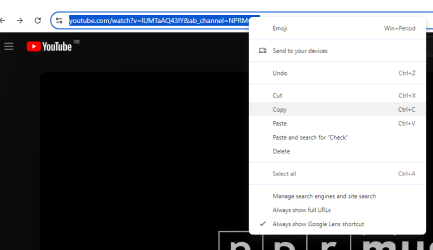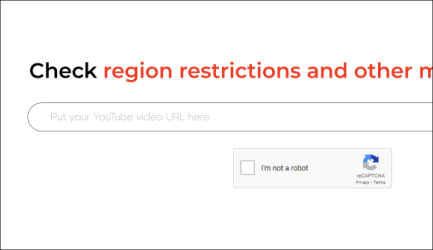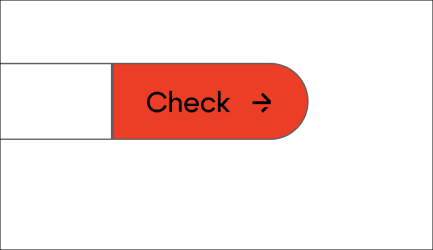Check YouTube Region / Country Restrictions And Other Video Metadata Online
Also see other video information: embedding status, whether embedding is enabled or disabled, YouTube video likes and dislike checker, view count, and whether the video is monetized.
FAQs
Why would a video be restricted or banned in some countries?
1. Copyright Issues: If a video contains copyrighted content,
like music, clips, or images that don’t have permission for
worldwide use, it may be blocked in countries where copyright
laws are more strictly enforced.
2. Content Policies and Community Standards: YouTube enforces
specific guidelines regarding violence, nudity, hate speech,
and other sensitive topics. If a video is flagged for
violating these guidelines, it may be age-restricted, removed,
or blocked in certain countries where the standards are
stricter.
3. Local Laws and Regulations: Some countries have laws
regulating content related to political speech, religion, drug
use, LGBTQ+ issues, or depictions of certain historical
events. If a video touches on any of these topics in ways that
are considered unlawful or culturally offensive, it might be
blocked there.
4. Government Censorship: In some countries, government
authorities may request YouTube to restrict access to certain
content that is considered subversive, politically sensitive,
or otherwise against state policies. YouTube sometimes
complies with these requests to maintain operations in those
countries.
5. Age Restrictions: Certain videos are marked as
“age-restricted” by YouTube if they contain mature or explicit
content. In some countries, age restrictions may be more
severe, leading to outright bans on certain content.
6. User-Reported Concerns: Sometimes, if enough users from a
particular country report a video as offensive, YouTube may
restrict it in that country while evaluating its content for
violations.
7. Network-Level Blocking: Occasionally, ISPs (Internet
Service Providers) in certain regions may block access to
YouTube entirely or certain channels and videos within the
platform, which is outside YouTube’s control.
Does any VPN switch your location on YouTube?
Yes, a VPN (Virtual Private Network) can change your virtual
location on YouTube. Here’s how it works:
1. How a VPN Changes Location: A VPN masks your real IP
address and replaces it with the IP address of the server
you’re connected to. For example, if you connect to a VPN
server in the United States, your internet traffic appears to
originate from the U.S., and YouTube will show content as if
you're browsing from there.
2. Accessing Location-Restricted Content: By changing your IP
address, a VPN allows access to YouTube content that might be
restricted in your actual country. This includes
region-specific videos or channels that YouTube restricts
based on location.
3. Streaming and VPN Restrictions: Some VPNs are better than
others at bypassing location-based restrictions, especially
because streaming services often try to detect and block VPN
use. Top VPN services (e.g., ExpressVPN, NordVPN, CyberGhost)
frequently update their IP addresses to avoid detection and
maintain access.
4. Limitations and Potential Issues: While many VPNs can
change your location, not all succeed in accessing restricted
content, as YouTube and other services continually improve
their VPN-detection methods. Additionally, using a VPN to
bypass restrictions may violate YouTube’s terms of service,
and some free or less secure VPNs can compromise streaming
quality or privacy.
If you choose to use a VPN to change your YouTube location,
it's best to select a reputable provider that ensures security
and stable access to international content.
May I use a free VPN to access content from other regions on YouTube?
Yes, you can use a free VPN to try to access content from
other regions on YouTube, but there are some limitations and
potential drawbacks to consider:
1. Speed and Bandwidth: Free VPNs often have slower speeds and
limited bandwidth, which can result in buffering or low video
quality on YouTube. Many free VPNs also have data caps, which
can quickly run out if you’re streaming video.
2. Reliability for Geo-Unblocking: Free VPNs may struggle to
unblock region-restricted content. YouTube and other streaming
services actively work to detect and block VPNs, especially
free ones, which often have fewer server options and are more
likely to be blacklisted.
3. Limited Server Locations: Free VPNs usually offer only a
few server locations, so you might not have access to the
specific region you need. Additionally, with fewer servers,
these locations are often crowded with users, leading to
slower connections.
4. Security and Privacy Risks: Some free VPNs lack proper
security protocols or may even collect your data and browsing
habits to sell to third parties. This can compromise your
privacy rather than protect it.
5. Unreliable Access: Free VPNs might not have the resources
to update their IP addresses frequently, making them easier
for YouTube to detect and block. Even if you find one that
works temporarily, it may not reliably unblock YouTube content
long-term.
If you need consistent access to YouTube content from other
regions, a reputable paid VPN is generally a better option due
to faster speeds, a larger selection of server locations, and
better privacy practices.
Which are the countries that have been banned by YouTube?
YouTube itself is generally available worldwide, but it is
either banned or heavily restricted in a few countries due to
government policies, censorship, or local regulations. The
countries that have restricted or banned YouTube at various
times include:
1. China: YouTube has been blocked in China since 2009 as part
of the country’s strict internet censorship policies. Instead,
China promotes local video platforms like Youku, Bilibili, and
Tencent Video, which are subject to government regulations.
Iran: Iran blocked YouTube in 2009 following political
protests. While some access may be available via VPNs, Iran
promotes its own platforms, and government restrictions
continue to limit open internet use.
2. North Korea: Internet access in North Korea is highly
restricted, with most citizens only having access to a
state-controlled intranet. YouTube is unavailable in the
country, and very few North Koreans have unrestricted access
to the global internet.
3. Turkmenistan: Known for strict internet censorship,
Turkmenistan restricts access to various websites, including
YouTube. The government carefully controls the media
landscape, limiting outside influences.
4. Sudan (previously): YouTube was previously restricted in
Sudan but has become accessible in recent years. However,
access may still be subject to periodic interruptions.
5. Syria: During periods of political unrest, Syria has
restricted access to YouTube and other social media. While
YouTube is sometimes accessible, restrictions remain in place
during specific periods.
6. Eritrea: While not officially blocked, internet access in
Eritrea is extremely limited, with few people having
connectivity and controlled access to international content,
effectively limiting YouTube access.
Other countries have restricted or blocked YouTube
temporarily, often during political events, elections, or
civil unrest. For example:
Turkey has previously blocked YouTube due to videos deemed
offensive to national figures but now allows access with some
monitoring.
Pakistan and Bangladesh have had temporary YouTube bans, often
due to content that was deemed offensive or in violation of
religious or cultural standards.
In countries where YouTube is restricted, people may still
attempt to access it using VPNs or proxies, although doing so
may sometimes violate local laws.
Why are some Youtube videos only allowed in one country?
Some YouTube videos are only available in specific countries
due to various legal, contractual, and regulatory reasons.
Here’s why:
1. Copyright and Licensing Agreements: Content creators, music
labels, or media companies often license their content for
specific regions based on distribution deals. For example, a
TV show might be licensed only for viewers in the United
States, meaning viewers in other countries won’t be able to
access it. This is common with music videos, movies, and other
copyrighted content.
2. Broadcast Rights and Regional Content Deals: Some content,
like sports broadcasts or exclusive shows, is limited to
certain regions due to complex licensing and broadcast rights
agreements. For example, a sports network may have the right
to stream games only in a particular country, limiting access
elsewhere.
3. Government Regulations: In some cases, governments impose
restrictions on specific types of content that can be viewed
within their country. For instance, certain videos related to
politics, religion, or social issues may be limited to
specific regions based on local regulations.
4. Content Sensitivity and Cultural Standards: Creators or
distributors might choose to restrict access to content based
on cultural sensitivity. A video that may be acceptable in one
country could be seen as controversial or offensive in
another, leading the creator to limit it to one specific
region.
5. Monetization and Ad Revenue: Some videos are only monetized
in certain countries due to YouTube’s advertising policies. In
these cases, creators may choose to limit access to their
primary target region to maximize ad revenue or avoid showing
ads in markets where monetization options are limited.
6. User Language and Target Audience: Sometimes, content
creators target their videos to a specific audience based on
language and local interests. A creator might restrict a video
to their home country to focus on a specific demographic or
cultural group.
7. Platform Testing and Region-Specific Releases: YouTube and
creators sometimes release videos, features, or services to a
limited audience as part of a test or trial. This may
temporarily limit access to one country or region.
These regional restrictions are managed through YouTube’s
geo-blocking feature, which checks a viewer’s IP address to
determine their location and apply content restrictions
accordingly.
YouTube Video Region Restrictions Checker
The YouTube Video Region/Country Restriction Checker is a useful
online tool that allows users to check if a YouTube video is
restricted in specific countries or regions. With this tool,
users can quickly see whether a particular video is accessible
or blocked based on their location. The tool is compatible with
standard YouTube links as well as YouTube Shorts, making it easy
for users of all experience levels to check for restrictions.
Whether you're a content creator seeking to understand where
your content is viewable or a viewer trying to access regionally
locked videos, the YouTube Video Region Restriction Checker
simplifies the process. It provides clear information on video
availability across various countries, helping you determine if
certain content is restricted in your area or accessible
worldwide.
This tool is especially valuable for individuals who
regularly deal with content affected by copyright, licensing
agreements, or government regulations that restrict access to
specific regions. By analyzing the availability of any given
YouTube link, users can avoid frustrating access issues and
find alternate solutions, like using a VPN, to watch
regionally restricted content if desired.

The Information You Get From This Tool:
In which countries is your YouTube content restricted? Which regions do your YouTube content have full access to? Always Updated and Precise Results
When you submit a YouTube-blocked video, it will generate an interactive map that highlights countries where your content is not available. The color-coded regions show whether or not the media can be accessed legally within each country – with red marking restricted areas and green indicating availability for all users across any region. Click on the map to find out which countries are not allowed access. You can also see a list of all those that do have permission, so you know what’s available for viewing.


